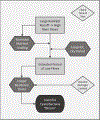Development of a Risk Characterization Tool for Harmful Cyanobacteria Blooms on the Ohio River
- PMID: 35450079
- PMCID: PMC9019831
- DOI: 10.3390/w14040644
Development of a Risk Characterization Tool for Harmful Cyanobacteria Blooms on the Ohio River
Abstract
A data-driven approach to characterizing the risk of cyanobacteria-based harmful algal blooms (cyanoHABs) was undertaken for the Ohio River. Twenty-five years of river discharge data were used to develop Bayesian regression models that are currently applicable to 20 sites spread-out along the entire 1579 km of the river's length. Two site-level prediction models were developed based on the antecedent flow conditions of the two blooms that occurred on the river in 2015 and 2019: one predicts if the current year will have a bloom (the occurrence model), and another predicts bloom persistence (the persistence model). Predictors for both models were based on time-lagged average flow exceedances and a site's characteristic residence time under low flow conditions. Model results are presented in terms of probabilities of occurrence or persistence with uncertainty. Although the occurrence of the 2019 bloom was well predicted with the modeling approach, the limited number of events constrained formal model validation. However, as a measure of performance, leave-one-out cross validation returned low misclassification rates, suggesting that future years with flow time series like the previous bloom years will be correctly predicted and characterized for persistence potential. The prediction probabilities are served in real time as a component of a risk characterization tool/web application. In addition to presenting the model's results, the tool was designed with visualization options for studying water quality trends among eight river sites currently collecting data that could be associated with or indicative of bloom conditions. The tool is made accessible to river water quality professionals to support risk communication to stakeholders, as well as serving as a real-time water data monitoring utility.
Keywords: big river; cyanobacteria; harmful algae bloom; predictive modeling; risk characterization.
Conflict of interest statement
Conflicts of Interest: The authors declare no conflict of interest.
Figures









References
-
- Ho JC; Michalak AM; Pahlevan N Widespread global increase in intense lake phytoplankton blooms since the 1980s. Nature 2019, 574, 667–670. - PubMed
-
- Huisman J; Codd GA; Paerl HW; Ibelings BW; Verspagen JMH; Visser PM Cyanobacterial blooms. Nat. Rev. Microbiol 2018, 16, 471–483. - PubMed
-
- Beaulieu M; Pick F; Gregory-Eaves I Nutrients and water temperature are significant predictors of cyanobacterial biomass in a 1147 lakes data set. Limnol. Oceanogr 2013, 58, 1736–1746.
-
- Adams CM; Larkin SL; Hoagland P; Sancewich B Assessing the Economic Consequences of Harmful Algal Blooms. In Harmful Algal Blooms: A Compendium Desk Reference; Shumway SE, Burkholder J, Morton SL, Eds.; John Wiley and Sons, Inc.: Hoboken, NJ, USA, 2018; pp. 337–354.
Grants and funding
LinkOut - more resources
Full Text Sources
